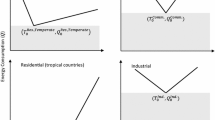Abstract
This article evaluates the impact of consumer choice programs, price caps, and sliding scale plans on consumer prices of gas using a custom survey of public service commissions and data from the Department of Energy. A seemingly unrelated regressions model estimates residential, commercial and industrial prices jointly, controlling for potentially endogenous demand. Consumer choice programs are estimated to lower residential and commercial prices significantly, by bringing competition to markets with smaller consumers. Prices fall even before deregulation as utilities build consumer loyalty and fight competition. Sliding scale plans are estimated to lower prices of small consumers while raising industrial prices. Price caps lead to overall higher prices, with unclear ranking across consumer classes.
Similar content being viewed by others
References
Ai C., Sappington D. (2002). The impact of state incentive regulation on the U.S. telecommunications industry. Journal of Regulatory Economics, 22(2): 133–160
Ai C., Martinez S., Sappington D. (2004). Incentive regulation and telecommunications service quality. Journal of Regulatory Economics, 26(3): 263–285
Averch H., Johnson L.L. (1962). Behavior of the firm under regulatory constraint. Am. Econ. Rev., 52(5): 1052–1069
Bailey E. (1973). Economic theory of regulatory constraint. Lexington, Heath & Company—Lexington Books
Beesley M., Littlechild S. (1989). The Regulation of privatized monopolies in the United Kingdom. RAND Journal of Economics, 20(3): 454–472
Bernstein J., Sappington D. (1999). Setting the X factor in price cap regulation plans. Journal of Regulatory Economics, 16(1): 5–26
Braeutigam R., Panzar J. (1993). Effects of the change from rate-of-return to price-cap regulation. American Economic Review, 83(2): 191–198
Commonwealth of Kentucky Public Service Commission (2000). Application of Louisville gas & Electric Co. for approval of an alternative method of regulation of its rates and service. Public Service Commission Proceedings.
Comnes, G., Stoft, S., Greene, N., & Hill, L. J. (1995). Performance-based ratemaking for electric utilities: Review of plans and analysis of economic and resource-planning issues. Working paper. Lawrence Berkeley National Laboratory, University of California, LBL-37577 UC-1320.
Crew M., Kleindorfer P. (1986). The Economics of public utility regulation. Cambridge Mass, MIT Press
Crew M., Kleindorfer P. (1996). Incentive regulation in the united kingdom and the united sates: Some lessons. Journal of Regulatory Economics, 9(3): 211–225
DOE—EIA (2004a). EIA–natural gas data, reports, analysis, surveys. Accessed April-17, 2007. http://www.eia.doe.gov/oil_gas/natural_gas/info_glance/natural_gas.html
DOE—EIA (2004b). Status of natural gas residential choice programs by state as of December 2003. Accessed April-17, 2007. http://www.eia.doe.gov/oil_gas/natural_gas/restructure/restructure.html
DOE—EIA (2005). Natural gas applications: Eia-176 query system. Accessed April-17, 2007. http://www.eia.doe.gov/oil_gas/natural_gas/applications/nat_applications.html
Finnoff D., Cramer C., Shaffer S. (2004). The Financial and operational impacts of FERC order 636 on the interstate natural gas pipeline industry. Journal of Regulatory Economics, 25(3): 243–270
Greenstein S., McMaster S., Spiller P. (1995). The Effect of incentive regulation on local exchange companies’ deployment of digital infrastructure. Journal of Economics and Management Strategy, 4(2): 187–236
Hlasny V. (2006). Do gas cost incentive mechanisms work? A nation-wide study. The American Economist, 50(1): 51–68
Hollas D. (1989). Firm/Interruptible gas pricing patterns in a regulated environment. Journal of Regulatory Economics, 1(1): 47–67
Hollas D. (1994). Downstream gas pricing in an era of upstream deregulation. Journal of Regulatory Economics, 6(3): 227–245
Hollas D. (1999). Gas utility prices in a restructured industry. Journal of Regulatory Economics, 16(2): 167–185
Jess, M. (1996). Consumer prices reflect benefits of restructuring. Technical report, DOE—EIA. Natural Gas 1996.
Lyon T. (1996). A model of sliding-scale regulation. Journal of Regulatory Economics, 9(3): 227–247
Majumdar S. (1997). Incentive regulation and productive efficiency in the US telecommunications industry. Journal of Business, 70(4): 547–576
Mariner-Volpe, B. (2000). The Evolution of gas markets in the united states. Online presentations, U.S. Department of Energy.
Mathios A., Rogers R. (1989). The impact of alternative forms of state regulation of AT&T on direct-dial, long-distance telephone rates. RAND Journal of Economics, 20(3): 437–453
Minnesota Public Utilities Commission (1999). Report on performance-based gas purchasing plans.
Myers, R., & Strain, L. (2000). Electric and gas utility performance based ratemaking mechanisms (September 2000 Update). Report, California Public Utilities Commission. http://www.cpuc.ca.gov/published/report/1978.htm
Ramsey F. (1927). A Contribution to the theory of taxation. Economic Journal, 37(145): 47–61
Sappington D. (2002). Price regulation. In: Cave M.E., Majumdar S.K., Vogelsang I. (eds). Handbook of telecommunications economics. Elsevier Science B.V., North-Holland
Shepherd W. (1972). The Elements of market structure. Review of Economics and Statistics, 54(1): 25–37
Taylor L. (1975). The Demand for electricity: A Survey. Bell Journal of Economics and Management Science, 6(1): 74–110
Vogelsang I. (2002). Incentive regulation and competition in public utility markets: A 20-year perspective. Journal of Regulatory Economics, 22(1): 5–27
Zellner A. (1962). An efficient method of estimating seemingly unrelated regressions and tests for aggregation bias. Journal of American Statistical Association, 57(298): 348–368
Author information
Authors and Affiliations
Corresponding author
Rights and permissions
About this article
Cite this article
Hlasny, V. The impact of restructuring and deregulation on gas rates. J Regul Econ 34, 27–52 (2008). https://doi.org/10.1007/s11149-007-9048-6
Published:
Issue Date:
DOI: https://doi.org/10.1007/s11149-007-9048-6




